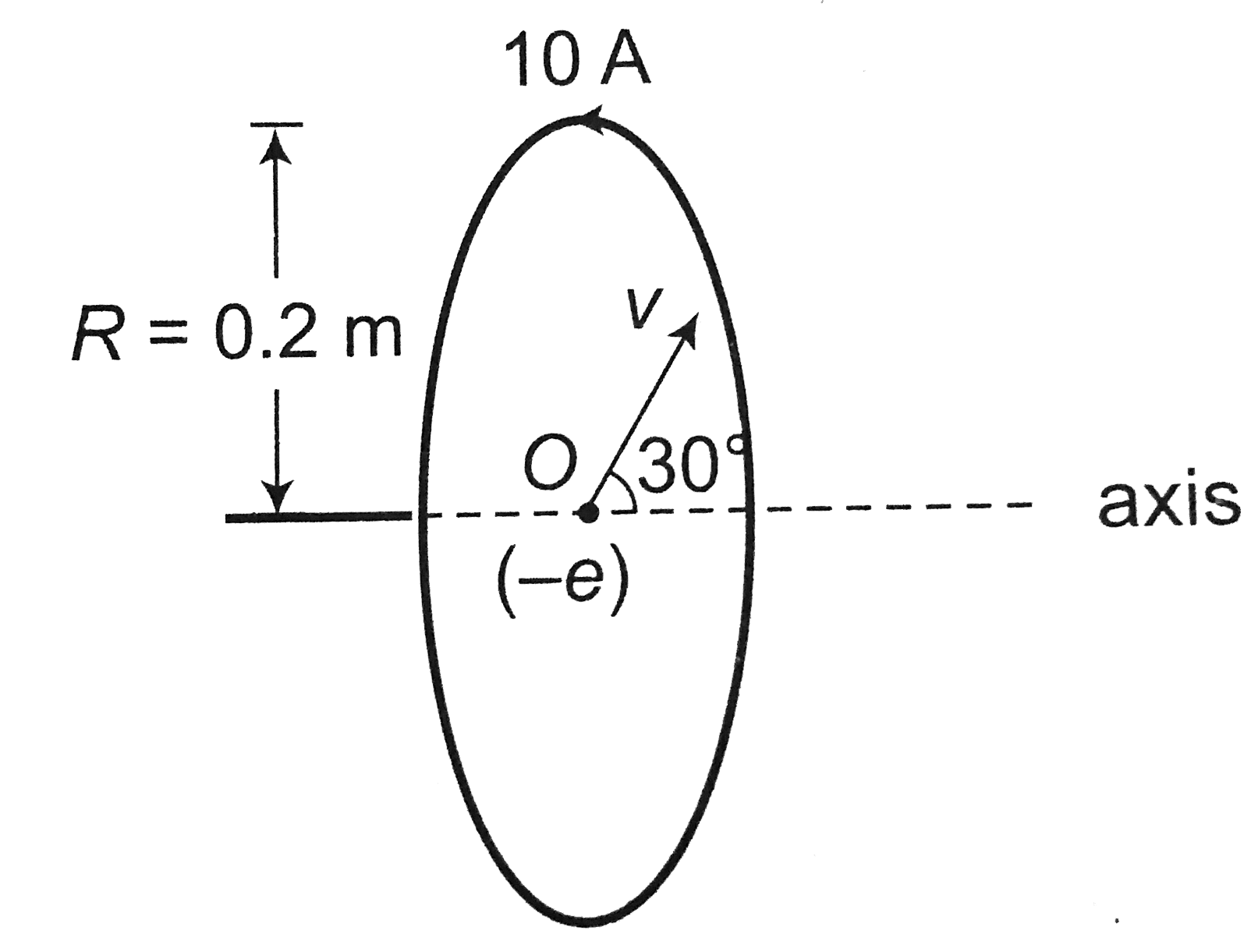(a) A particle of mass 1mg and having charges 1μC is moving in a magnetic field →B=2ˆi+3ˆj+kT, with velocity →v=2ˆi+ˆj−ˆkm/sec. Find magnetic force in vector form and magnitude of acceleration.
(b) A magnetic field of 8ˆkT exerts a force 8ˆi+6ˆjN on a particle having a charge 2C and going in x−y plane. Find the velocity of the particle.
( c) A particle is moving in a magnetic field 3ˆi+4ˆjT and acceleration of particle is λˆi+3ˆjm/sec2. Find the value of λ.
(d) When a proton has a velocity bec(v)=(2ˆi+3ˆj)×106m/sec it experiences a force →F=(−1.28×10−13→k)N. When its velocity is along the z-axis, it experiences a force along the x-axis. What is the magnetic field ?
(e) A circular loop of radius 20cm carries a current of 10A. An electron cross the plane of the loop with a speed of 2.0×106m/sec. The direction of motion makes an angle centre. Find the magnitude of the magnetic force on the electron at the instant it crosses the plane.
(a) m=1mg=10−6kg,q=1μC=10−6C
→B=2ˆi+3ˆj+ˆkT,→v=2ˆi+ˆj−ˆkm/sec
→F=q→v×→B=10−6∣∣
∣
∣∣ˆiˆjˆk21−1231∣∣
∣
∣∣
→a=→Fm=10−610−6(4ˆi−4ˆj+4ˆk)
=4ˆi−4ˆj+4ˆkm/sec2
|→a|=a=4√3m/sec2
(b) The particle is moving in x−y plane, hence its velocity
→v=vxˆi+vyˆjm/sec
q=2C,→B=8ˆkT,→F=8ˆi+6ˆjN
→F=q→v×→B=2∣∣
∣
∣∣ˆiˆjˆkvxvy0008∣∣
∣
∣∣
=2[8vyˆi−16vxˆj]
8ˆi+6ˆj=16vyˆi−16vxˆj
Comparing coefficient of ˆi and ˆj
16vy=8⇒vy=12
−16vx=6⇒vx=−38
→v=vxˆi+vyˆj=−38ˆi+12ˆjm/sec
( c) →B=3ˆi+4ˆjT,→a=λˆi+3ˆjm/sec2
Since →F=q→v×→B,→F is ⊥ar to →v as wll as →B
→F=m→a, hence →a is ⊥ar to →B
The dot product of perpendicular vectors is zero.
→B.→a=0
(3ˆi+4ˆj).(λˆi+3ˆj)=0
λ=−4
(d) →v=(2ˆi+3ˆj)×106m/sec,→F=−(1.28×10−13ˆk)
Since →Fis ⊥ar to →B,→B should be in x−y plane
Let →B=Bxˆi+Byˆj
→F=q→v×→B=(1.6×10−9)∣∣
∣
∣∣ˆiˆjˆk2×1063×1060BxBy0∣∣
∣
∣∣
−(1.28×10−13)ˆk=(1.6×10−19×106)[2By−3Bx]ˆk
2By−3Bx=0.8 ...(i)
Let →v=v0ˆk,→F=F0ˆi
→F=q→v×→B
F0ˆi=q(v0ˆk)×(Bxˆi+Byˆj)
=qv0[Bxˆj−Byˆi]
=qv0Bxˆi−qv0Byˆi
Comparing coefficient of j : qv0Bx=0⇒Bx=0
2By−3Bx=0.8⇒By=0.4
→B=0.4ˆjT
(e) 
Magnetic field centre of loop
B=μ0i2R=(4π×10−7)(10)2×0.2=π×10−5T, along x-axis
→B=π×10−5ˆiT
Velocity of electron, |→v|=v=2×106m/sec
→v=vcos30∘ˆi+vsin30∘ˆj=(√3ˆi+ˆj)×106m/sec
→F=q→v×→B=(−1.6×10−19)∣∣
∣
∣∣ˆiˆjˆk√3×106106010−5π00∣∣
∣
∣∣
=(1.6×10−19)(106)(10−5π)ˆk
=1.6π×10−18ˆkN
∣∣→F∣∣=1.6π×10−18N
Topper's Solved these Questions
Similar Questions
Knowledge Check
- Question 1 - Select One
A charged particle with charge to mass ratio (qm)=(10)319Ckg−1 enters a uniform magnetic field →B=20ˆi+30ˆj+50ˆkT at time t = 0 with velocity →V=(20ˆi+50ˆj+30ˆk)m/s. Assume that magnetic field exists in large space.
During the further motion of the particle in the magnetic field, the angle between the magnetic field and velocity of the particleAremains constantBincreasesCdecreasesDmay increase or decrease - Question 2 - Select One
An electron is moving with a velocity (2ˆi+2ˆj)m/s is an electric field of intensity →E=ˆi+2ˆj−8ˆkV/m and a magnetic field of →B=(2ˆj+3ˆk) tesla. The magnitude of force on the electron is
A14.4×10−19NB9×10−19NC11.2×10−19ND6.4×10−19N
If →a=ˆi+2ˆj+3ˆk and →b=2ˆi+3ˆj+ˆk , find a unit vector in the direction of (2→a+→b).
View SolutionA point charge +q0 is projected in a magnetic field →B=(ˆi+2ˆj−3ˆk). If acceleration of the particle is →a=(2ˆi+bˆj+ˆk) then value of b will be
View SolutionA point charge +q0 is projected in a magnetic field →B=(ˆi+2ˆj−3ˆk). If acceleration of the particle is →a=(2ˆi+bˆj−ˆk) then value of b will be
View SolutionA charge particles q enters in a magnetic field →B=yˆi+xˆj with the velocity →v=xˆiyˆj . Neglect any force other than magnetic force. Now answer the following question.
Magnetic force F acting on charge is proportional to –View SolutionA charge particles q enters in a magnetic field →B=yˆi+xˆj with the velocity →v=xˆiyˆj . Neglect any force other than magnetic force. Now answer the following question.
Which of the following is true for the direction of magnetic force ?View SolutionA charged particle with charge to mass ratio (qm)=(10)319Ckg−1 enters a uniform magnetic field →B=20ˆi+30ˆj+50ˆkT at time t = 0 with velocity →V=(20ˆi+50ˆj+30ˆk)m/s. Assume that magnetic field exists in large space.
During the further motion of the particle in the magnetic field, the angle between the magnetic field and velocity of the particleView Solution

